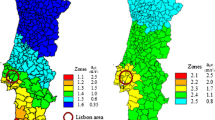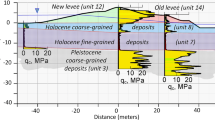Abstract
The post-liquefaction residual strength of soils often plays a key role in the seismic stability analysis of embankment dams and other earth structures. A commonly held view is that back analyses of field case histories of liquefaction flow failures offer at present the most practical approach for estimating the residual strength of liquefied soils. Thus, it is common in engineering practice to estimate this strength parameter based on empirical correlations. However, the available data for such correlations are very limited and represent only a small range of conditions encountered in practice. Thus, use of the correlations in practice generally involves considerable uncertainty. A case history is presented that illustrates questions that are often encountered in practice and that would benefit from additional research, perhaps by means of centrifuge testing and numerical modeling.
You have full access to this open access chapter, Download conference paper PDF
Similar content being viewed by others
1 Background and Thesis Statement
The post-liquefaction residual strength of soils often plays a key role in the seismic stability analysis of embankment dams and other earth structures. A commonly held view is that back analyses of field case histories of liquefaction flow failures offer at present the most practical approach for estimating the residual strength of liquefied soils. Thus, it is common in engineering practice to estimate this strength parameter based on empirical correlations.
Published relationships have been developed by relating the residual strength of soils back-calculated from case histories of liquefaction flow failure to soil indices such as the standard penetration test (SPT ) blow count or the cone penetration test (CPT ) tip resistance (and the vertical effective consolidation stress). However, the available data are very limited and exhibit large scatter, and the case histories represent only a small fraction of the range of soil types, site conditions, consolidation stresses, and geologic settings encountered in practice. Thus, application of the correlations to any one practical problem generally involves a great deal of uncertainty and requires the exercise of judgment.
It is now recognized by many geotechnical engineers that the residual strength of liquefied soil is a characteristic of a specific soil-structure system (i.e., a system parameter) as opposed to a property of the soil, and that it depends on many factors. One key factor is the potential for void redistribution in the soil after liquefaction triggering. Void redistribution results from the collapse of the soil structure and the tendency for densification of the soil upon triggering and has been shown to be a function of the thickness of a liquefied soil layer and the density (initial void ratio) of the liquefied soil (e.g. Malvick et al. 2006).
Many cases arise in practice for which additional information on the effects of soil layer thickness and of density on void redistribution would be helpful in evaluating the range of values of residual strength to be used in a stability analysis. Furthermore, the analysis of seismic deformations and of potential gross instability in such cases would benefit considerably from insight into the ability of available numerical analysis procedures and constitutive models to simulate void redistribution of soils after liquefaction triggering. One example case is the seismic evaluation of Calero Dam, which is briefly described below. A more complete description of the case history is presented by Mejia et al. (2014).
2 Calero Dam Seismic Evaluation
Built in 1935 and located in Santa Clara County, California, Calero Dam is a 100-foot-high compacted earthfill embankment that straddles a wide valley blanketed by 15–20 ft of alluvium overlying bedrock. As shown in Fig. 35.1, the embankment consists of upstream and downstream zones and a seepage cutoff trench excavated through the alluvium. The alluvium was stripped from beneath the embankment upstream of the cutoff trench but was left in place downstream of the trench.
The lower 5–10 ft of the alluvium consists of medium dense gravelly sands with 10–20% low-plasticity fines, whereas the upper 5–10 ft consist of clayey sands and sandy clays of medium plasticity. The upstream and downstream embankment materials are generally similar and consist of dense clayey sands with gravel.
Two piezometric surfaces are discerned from piezometer data at the site. The lower piezometric surface, shown in Fig. 35.1, applies to the foundation alluvium downstream of the cutoff trench, whereas the upper surface applies to the embankment.
Although the dam withstood the 1989 Loma Prieta Earthquake with only minor effects, the dam could be vulnerable to large earthquakes on the San Andreas and Calaveras faults, located within 20 km to the west and east, and earthquakes on other active faults within a few kilometers of the site. Large earthquakes on the nearby faults could generate ground motions characterized by peak horizontal rock accelerations exceeding 1 g, whereas the Loma Prieta Earthquake generated peak accelerations of about 0.3 g.
Extensive field investigations with the SPT and the Becker Penetration Test (BPT) showed that the corrected, normalized SPT blow count, (N1)60, in the lower alluvium ranges between about 6 and 30 and averages about 17, suggesting an overall medium dense condition for that soil. Thus, while the embankment and upper alluvium materials are not susceptible to liquefaction, the potential for liquefaction triggering in the lower alluvium during intense earthquake shaking was a key consideration in the seismic evaluation of the dam.
Likewise, assessment of the post-liquefaction residual strength of the lower alluvium, should liquefaction trigger in that layer, was a key issue in the dam stability analysis and required careful consideration of uncertainty and exercise of judgment. The question of uncertainty was further underscored by the fact that key characteristics of the dam and its foundation are outside the range represented by case histories in the database of liquefaction flow failures. A key question was the potential for liquefaction triggering and for void redistribution in a 10-foot-thick layer of gravelly sand with an average blow count of about 17.
3 Concluding Remarks
The Calero Dam case history illustrates questions that are often encountered in practice in the seismic stability analysis of embankment dams and that would benefit from additional research, possibly through physical modeling by centrifuge tests and numerical modeling. Such questions include the following: Can significant void redistribution and flow failure (i.e., large deformations) occur within a relatively thin confined layer of medium-dense cohesionless soil under significant vertical effective stress? How are the potential for void redistribution and flow failure under such conditions affected by the thickness of the liquefied soil layer? How are they affected by soil relative density? Are numerical analyses with available constitutive models able to simulate void redistribution and large deformations in those types of situations?
The above questions might be answered, at least in part, through a program of centrifuge testing and numerical modeling to simulate development of flow failure of earth embankments underlain by varying layer thicknesses of liquefaction-susceptible soil of varying relative densities. Perhaps such a program could be undertaken within the LEAP framework.
References
Malvick, E. J., Kutter, B. L., Boulanger, R. W., & Kulasingam, R. (2006). Shear localization due to liquefaction-induced void redistribution in a layered infinite slope. Journal of Geotechnical and Geoenvironmental Engineering, ASCE, 132(10), 1293–1303.
Mejia, L., Wu, J., Newman, E., & Mooers, M. (2014). Seismic stability evaluation of dam underlain by coarse-grained alluvium. In Proceedings of U.S. Society on Dams Annual Meeting and Conference, San Francisco, CA.
Author information
Authors and Affiliations
Corresponding author
Editor information
Editors and Affiliations
Rights and permissions
Open Access This chapter is licensed under the terms of the Creative Commons Attribution 4.0 International License (http://creativecommons.org/licenses/by/4.0/), which permits use, sharing, adaptation, distribution and reproduction in any medium or format, as long as you give appropriate credit to the original author(s) and the source, provide a link to the Creative Commons license and indicate if changes were made.
The images or other third party material in this chapter are included in the chapter's Creative Commons license, unless indicated otherwise in a credit line to the material. If material is not included in the chapter's Creative Commons license and your intended use is not permitted by statutory regulation or exceeds the permitted use, you will need to obtain permission directly from the copyright holder.
Copyright information
© 2020 The Author(s)
About this paper
Cite this paper
Mejia, L.H. (2020). Selected Issues in the Seismic Evaluation of Embankment Dams for Possible Investigation by LEAP. In: Kutter, B., Manzari, M., Zeghal, M. (eds) Model Tests and Numerical Simulations of Liquefaction and Lateral Spreading. Springer, Cham. https://doi.org/10.1007/978-3-030-22818-7_35
Download citation
DOI: https://doi.org/10.1007/978-3-030-22818-7_35
Published:
Publisher Name: Springer, Cham
Print ISBN: 978-3-030-22817-0
Online ISBN: 978-3-030-22818-7
eBook Packages: EngineeringEngineering (R0)





